Aloe vera plants are highly valued for their numerous benefits, including their soothing gel and air-purifying qualities. However, like any plant, they are susceptible to sunburn if exposed to excessive sunlight. Sunburnt Aloe vera plants display various symptoms, such as yellowing, reddening, or browning of the leaves. If you find yourself with a sunburnt Aloe vera plant and are seeking ways to revive it, this guide will provide you with helpful strategies. In the following sections, we will explore the symptoms of a sunburnt Aloe vera plant and share effective methods to restore its health, ensuring that your cherished plant can thrive once again.
Signs of a sunburnt Aloe plant include color changes in the leaves, such as yellowing, reddening, or browning. To revive an Aloe vera plant, it should be moved to a shadier area and its exposure to sunlight should be gradually increased. There are several other methods to revive a browning Aloe plant if it has received excessive light. The recovery process depends on the extent of the damage, and we can take appropriate measures accordingly.
Will sunburnt aloe recover?
Yes, Aloe plant can can recover from sunburnt naturally by providing indirect bright light and a little bit of care on watering. Yes it may lose some foliage but overall the aloe plant will recover from sunburnt problems.
Aloe plant leaves are damaged by Hot summer if you were growing it outdoors. These brown leaves in aloe can further spread from tips/edges to middle then burn the whole leaf. Reviving aloe can be possible if you take out the whole plant and repot it in Pot.
A Sunburnt aloe plant indicates less water so first you have to clean all the intact soil from the roots and put the aloe plant roots in a glass of water. Just use distilled water and let it stay that way for 2-3 days. After 3 days you will notice some brown leaves is getting green color back. This is the time you can repot the plant in a pot and place it in indirect sunlight.
It’s Recovered now So Keep the soil moist and continue this, it will take 2-3 weeks to see damaged leaves to turn back the colors. yes not all leaves will recover but at least we can save the plant and some of its leaves.
About Aloe Vera :
| Family | Asphodelaceae |
| Scientific Name | Aloe barbadensis miller |
| Native | Arabian Peninsula |
| Other Names | Cape aloe,Aloe plant, Chinese aloe, Barbados Aloe |
| Plant Type | Perennial, Succulent |
| Hardiness zone | 4a to 8b |
| Grown | Pots, Containers, Gardens, |
| Height | 24-40 inches(50-101cm) |
| Growth rate | Slower |
| Soil | Well draining, Fertile |
| Light Requirement | Partial Sunlight, Full Sun(Can Tolerate) |
| Fertilizer | Liquid based |
| USDA hardiness | Zone 8 – 11 |
| Blooming Season | Summer |
| Flower Color | Orange, Red, Yellow |
| Leaf Color | Green, Spiky Shape |
| Growth Rate | Slow growing |
| Benefits | For Skin and Body |
| Uses | Cosmetics, skin creams |
| Toxicity | Mild toxic |
Aloe vera varieties :
Aloe vera has more than 400+ species so I am naming the popular ones.
- Aloe Maculata
- Aloe Broomii
- Aloe Ferox
- Aloe Aculeata
- Aloe Perryi
- Aloe Nyeriensis
- Aloe Succotrina
- Aloe Capitata, etc
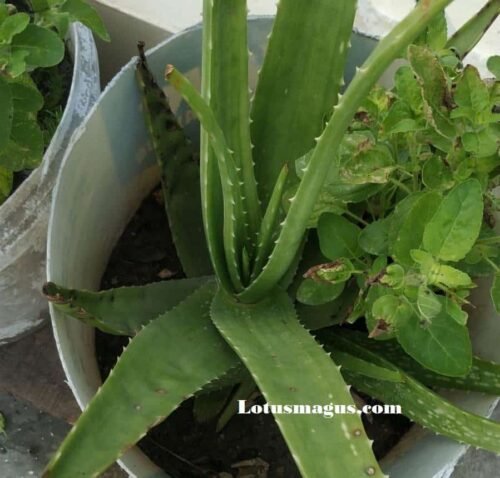
5 Symptoms Of A Sunburnt Aloe Vera Plant
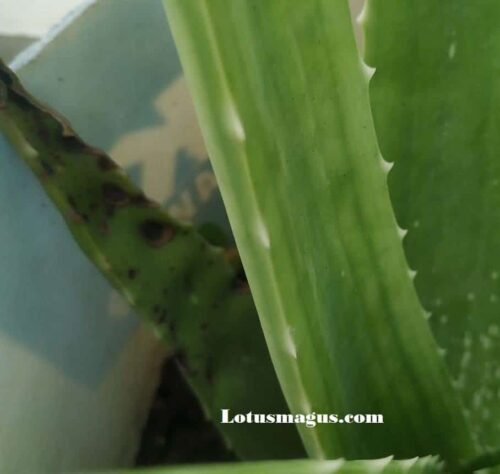
There are 5 symptoms that can tell if aloe vera plant is sunburnt. Following are the Known Symptoms includes:
- Browning of Leaves
- Yellowing foliage
- Soil Dried Fully
- Leaf Spots
- Leaf Tips Browning
There are various reasons but Sunburnt is the major reason why leaves turn brown and soil seems dry.
1. Light Problem
Excessive exposure to sunlight can lead to sunburn and other symptoms in an Aloe vera plant. While Aloe plants can tolerate some direct sunlight, prolonged and intense exposure can cause wilting, browning of leaves, and severe damage if not promptly addressed.
When an Aloe vera plant is placed in an area with excessive sunlight, such as a spot already receiving intense sun, it undergoes shock due to the excessive sun exposure. Even with proper watering, Aloe plants may still develop leaf spot burns when adapting to sunlight. Therefore, it is important to find a suitable spot for the plant that receives partial sunlight, such as morning or evening sun, to ensure its well-being.
If an Aloe vera plant becomes sunburnt, it has the potential to regrow and recover from the damage. Placing the plant in a shaded or partially shaded area allows it to recuperate. By removing the plant from direct sunlight and providing a more moderate light environment, the damaged leaves can regenerate. Typically, a sunburnt Aloe plant can regrow and recover around 50-70% of the damage if placed in a shade to partial shade area.
When growing Aloe plants indoors, south-facing windows are considered ideal as they provide ample sunlight throughout the day. The natural light received through these windows is usually sufficient for the plant’s growth and well-being. However, if well-lit areas or south-facing windows are not available, artificial lighting can serve as an alternative. By supplementing the plant with artificial light sources like grow lights, it is possible to provide the necessary light energy for photosynthesis and promote healthy growth.
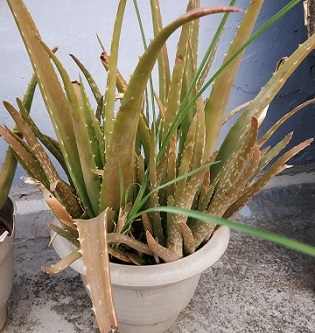
2. Pests Problem
If aloe vera plants are not exposed to excessive sunlight, they may become vulnerable to various pests, including scales, mealybugs, and mites. These pests feed on the inner fluid of the plant, leading to damage on the leaves and stems. As a result, the affected areas may turn brown, develop leaf spots, or dry out. To address this issue, it is important to employ effective pest control methods.
One common approach is to use pesticides or miticides specifically designed to combat these pests. By following the instructions on the product label, you can apply these chemicals to eliminate or repel the bugs, preventing further damage to the aloe vera plant. It is crucial to exercise caution and apply these substances safely and effectively.
Alternatively, neem oil can serve as a natural remedy to combat the pests on aloe plants. Neem oil possesses insecticidal properties that can help control infestations. Dilute the neem oil as instructed and apply it to the affected parts of the plant. Repeat this process as necessary until the pests are eradicated.
In severe cases where the infestation is extensive, pruning becomes necessary. Pruning involves the removal of heavily infested parts, such as leaves and stems, to prevent the pests from spreading further. Ensure that your pruning tools are clean and sharp to minimize the risk of introducing additional damage or infection. Properly dispose of the infested plant material to prevent the pests from re-infesting the aloe vera plant or spreading to other plants.
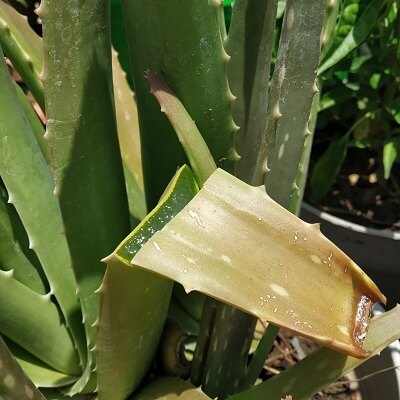
3. Overwatering
Overwatering is a common cause of the issues mentioned earlier. While aloe plants do require moist soil, it’s important to note that they also have the ability to store water in their leaves as a backup in case they don’t receive water for a few days. Daily watering is not recommended for aloe plants, as it can lead to root rot, resulting in browning and yellowing of leaves.
To address the problem of an overwatered aloe plant, it’s necessary to reduce watering for a few days to allow the plant to recover. During this time, the excess moisture in the soil will gradually dissipate, enabling the roots to regain their health. It is crucial not to provide any additional water during this period to prevent further damage.
To determine when it’s time to resume watering, you can perform a simple soil moisture test. Insert your index finger about 1-2 inches deep into the soil. If you feel moisture when you remove your finger, it indicates that the soil is still damp and doesn’t require watering. However, if the soil feels completely dry, it’s a sign that the plant needs water. In such cases, water the plant until the excess moisture begins to drain out from the bottom of the pot. This ensures thorough watering, reaching the root zone effectively.
By following this watering approach, you can maintain the proper moisture balance for your aloe plant, preventing overwatering and the associated problems. Regularly checking the soil moisture and adjusting your watering frequency accordingly will help keep your plant healthy and prevent issues like root rot.
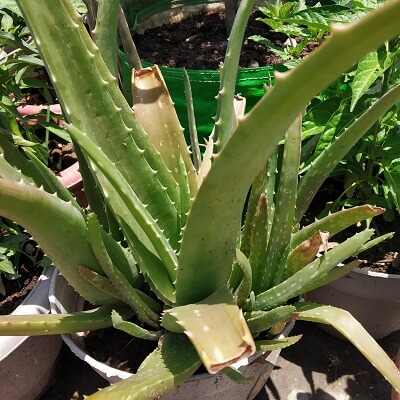
4. Ideal Temperature
Aloe plants can grow in 65- 75 degree F temperature and below 49 degrees F it can be bad for your aloe plant. Even It gets affected by the place it was growing, it has changed and now it is growing indoors. It takes time to adjust to the new environment and the shock it gets makes the foliage somewhat brown and it may lose some leaves but yes it can grow again if the environment is healthy like indirect light and sufficient watering works best.
If you move your plants outdoors in the mid of summers it is too hot and can result in sunburnt aloe plant. So if you have a tree in your garden place the pot there, else you can still give aloe direct sun but remember it requires more water then hot days. Some leaves might burn and give leaf spots but it will grow. I do this if I need aloe cuttings for propagation as sunlight enhances the growth of aloe vera plants.
If you want your aloe plant to be healthy just grow another plant near this and let it shade the aloe to provide partial light and help the aloe to grow. This way your plant won’t get sunburnt. In Winters If your plant is in a pot it can easily be transferred inside the house for warmer temperature but if you were growing aloe in the garden then you frost a blanket to cover your plant even at night to protect it from getting freeze.
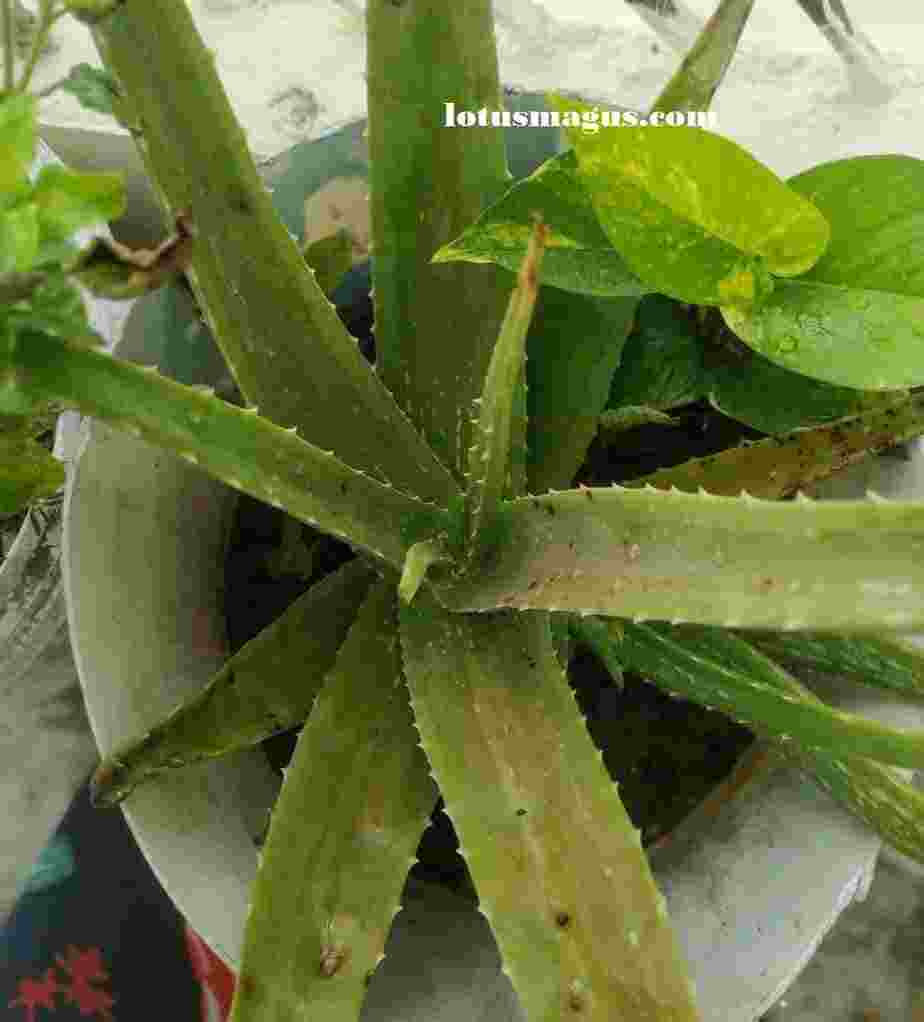
5. Potting Soil
Aloe vera plants have the ability to grow in poor soil conditions, but if you desire optimal growth, it is recommended to use well-drained, nutrient-rich soil. A well-draining soil helps prevent issues such as root rot, which can result in brown tips and overall leaf browning in succulents.
Choosing a well-drained soil is crucial for aloe vera plants, as they are adapted to arid environments and possess shallow root systems. Soil that retains excessive moisture can lead to waterlogged roots and subsequent root rot, which negatively affects the plant’s health. By utilizing well-draining soil, excess water can flow away from the roots, reducing the risk of root rot.
In addition to good drainage, providing nutrient-rich soil can greatly contribute to the growth of aloe vera plants. Incorporating organic matter and essential nutrients into the soil can supply the necessary elements for optimal development. This can be achieved by using a combination of compost, aged manure, and a suitable succulent or cactus potting mix. Such a soil blend ensures that the aloe plant receives the nutrients it needs to thrive and produce healthy foliage.
When potting an aloe vera plant, it is important to select a pot with proper drainage holes to facilitate water drainage. This prevents excess water from accumulating in the soil and causing waterlogged conditions. Regularly monitor the moisture levels in the soil and adjust the watering frequency accordingly, allowing the soil to dry out between watering sessions.
By providing your aloe vera plant with well-draining, nutrient-rich soil, you create an environment that promotes optimal growth and minimizes the risk of root rot. Remember to choose a soil mix specifically designed for succulents and cacti or create your own blend by incorporating organic matter. With the right soil conditions, your aloe vera plant will thrive, displaying vibrant and healthy foliage.
Either use a good potting soil mix or use perlite and fertilizer in your garden soil to fulfill its requirements.
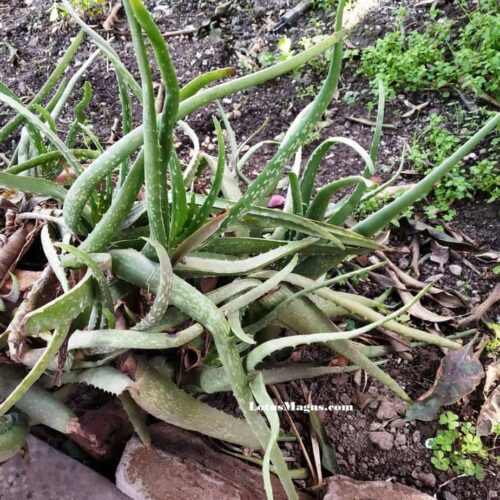
How do you revive sunburnt aloe vera plant?
To revive a sunburnt Aloe vera plant, there are several effective methods you can employ. One approach is to move the entire pot indoors and provide the plant with small amounts of water on a daily basis. This allows the Aloe vera plant to recover and regain its green color within a span of approximately 10 days. However, it’s important to note that during the recovery process, some damaged leaves may be lost.
Moving the sunburnt Aloe vera pot indoors offers several advantages. Firstly, it protects the plant from further exposure to intense sunlight, which can exacerbate the sunburn damage. Indoor conditions tend to be more moderate and controlled, providing an environment where the plant can recover without the risk of additional sunburn.
When it comes to watering the sunburnt Aloe vera plant, it’s crucial to exercise caution. Aloe vera plants do require water, but overwatering can lead to root rot and further harm the plant. The goal is to provide the plant with small amounts of water each day, ensuring that the soil remains slightly moist but not excessively saturated. This gradual approach allows the Aloe vera plant to absorb the necessary moisture without overwhelming its weakened state.
During the recovery period, it’s important to closely monitor the progress of the plant. Within the span of 10 days, the Aloe vera leaves may start to regain their green color as they heal. It’s normal for some damaged leaves to wither and be shed during this time. This natural process allows the plant to redirect its resources towards healthier leaves and overall growth.
Another method to revive a sunburnt Aloe vera plant is by placing it in water instead of soil. When submerged in water, the Aloe vera plant is less susceptible to pathogens that may be present in the soil. This can potentially expedite the recovery process compared to using soil as a medium. However, it’s important to ensure that the water used is clean and free from any contaminants that could harm the plant. Additionally, regular monitoring of the water level and changing it when necessary is crucial to maintain a healthy environment for the Aloe vera plant.
Both approaches—moving the pot indoors and gradually watering the plant or using water as a medium—can effectively revive a sunburnt Aloe vera plant. The total time required for the plant to recover from sunburn can vary depending on the severity of the damage and the overall health of the plant. Patience and attentive care are key during this period, as the Aloe vera plant gradually regains its vitality and returns to a healthy state.
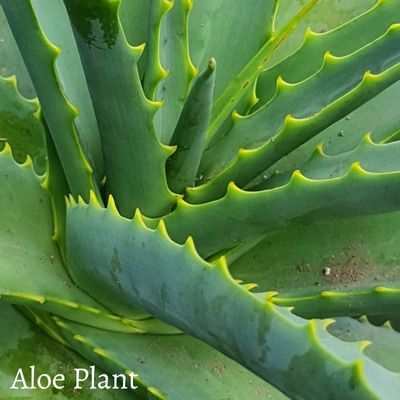
Why does my aloe plant turn brown in the sun?
Sunburn and browning of leaves in Aloe vera plants are often caused by excessive exposure to sunlight and resulting water loss. However, other factors such as overwatering, dry soil, fungal root rot, nutrient deficiencies, and excessive fertilization can also contribute to the browning of leaves. To address these issues and revive a sunburnt Aloe vera plant, there are several steps you can take.
One effective strategy is to change the location of the plant pot to a spot with partial shade. This helps reduce the direct exposure to intense sunlight and provides some relief from the heat. By finding a suitable location that offers partial shade, you create a more favorable environment for the Aloe vera plant to recover and prevent further sunburn damage.
In addition to adjusting the pot’s location, it is crucial to provide the Aloe vera plant with appropriate watering. While it is important to avoid overwatering, ensuring that the plant receives sufficient moisture is equally vital. The watering frequency depends on various factors such as climate, pot size, and soil moisture levels. A practical approach is to check the soil moisture by inserting your finger about an inch into the soil. If it feels dry, it indicates the need for watering. However, if it feels moist, it is advisable to wait before watering again. This balanced watering approach helps prevent both underwatering and overwatering, which can contribute to leaf browning.
Aside from adjusting the pot’s location and watering routine, it is essential to assess the overall health of the Aloe vera plant. Factors like fungal root rot or nutrient deficiencies in the soil can lead to leaf browning. If you suspect root rot, carefully inspect the roots and trim any infected portions. Repotting the plant in fresh, well-draining soil can provide a healthier environment for root recovery.
Moreover, ensuring that the Aloe vera plant is grown in fertile soil is important for its overall health. If you suspect nutrient deficiencies, you can consider using a balanced fertilizer specifically formulated for succulent plants. However, it is crucial to follow the instructions provided with the fertilizer and avoid over-fertilization, as this can cause further harm to the plant.
Read about 7 Reasons Why Is My Aloe Plant Turning Brown?
FAQ’s
1. Can a sunburnt aloe plant recover?
Yes, a sunburnt aloe plant can recover if provided with proper care and conditions. Aloe plants have the natural ability to regenerate and heal themselves over time.
2. What to do if aloe is sunburned?
If your aloe plant is sunburned, you should take the following steps:
– Move the plant to a shaded or indoor location away from direct sunlight.
– Avoid watering the plant until it has fully recovered to prevent further stress on the damaged tissue.
– Trim off any severely damaged or dead leaves using clean, sharp scissors or pruning shears. Be sure to leave some healthy foliage for the plant to recover.
– Provide adequate ventilation and ensure the plant is not exposed to extreme temperatures.
3. What happens if aloe vera gets too much sun?
If aloe vera gets too much sun, it can experience sunburn. The leaves may turn brown, red, or yellow and appear dry or shriveled. Overexposure to intense sunlight can damage the plant’s tissues and hinder its ability to photosynthesize properly.
4. Does aloe vera repair sun damage?
Yes, aloe vera possesses natural healing properties that can aid in repairing sun damage. The gel found inside the leaves of an aloe plant contains compounds that promote skin healing, soothe inflammation, and moisturize damaged tissues. Applying aloe vera gel topically on sunburned skin can help alleviate pain and expedite the healing process.
5. How long does it take for an aloe vera burn to heal?
The healing time for an aloe vera burn can vary depending on the severity of the burn and the care provided. In mild cases, it may take approximately one to two weeks for the plant to fully recover. However, more severe burns may require several weeks or even months for new healthy leaves to grow and replace the damaged ones.
6. Should I remove damaged aloe leaves?
Yes, it is advisable to remove severely damaged or dead leaves from the aloe plant. Trimming off the damaged leaves allows the plant to redirect its energy toward healing and new growth. However, ensure that some healthy foliage remains so that the plant can continue to photosynthesize and recover.
7. How do you fix a damaged aloe vera plant?
To restore a damaged aloe vera plant, follow these steps:
- Transfer the plant to a shaded or indoor location with indirect sunlight.
- Avoid overwatering the plant until it recovers to prevent root rot.
- Trim off any severely damaged or dead leaves while leaving some healthy foliage.
- Provide proper ventilation and prevent exposure to extreme temperatures.
- Consider applying aloe vera gel on the damaged leaves to soothe and promote healing.
8. What does an unhealthy aloe plant look like?
An unhealthy aloe plant may exhibit the following signs:
- Yellowing or browning of leaves, indicating stress or nutrient deficiency.
- Soft or mushy leaves, suggesting overwatering and potential root rot.
- Withered or shriveled leaves, indicating dehydration or insufficient water.
- Stunted growth or lack of new leaf growth over an extended period.
- Presence of pests or diseases on the plant, such as mealybugs, scale insects, or fungal infections.
- Unusual odor or discolored gel inside the leaves, suggesting decay or bacterial infection.
If your aloe plant displays any of these signs, it is important to assess its care routine and address any underlying issues promptly.
Final Words
For me a Sunburnt aloe plant is easy to revive and above I have explained my whole method and how you successfully revive it. After reviving you should take good care for your aloe plant as this can happen again. I suggest don’t be late at watering aloe plant and moving it in indirect bright area would make your aloe Vera happy.
If you want to read more such posts check below. I hope you get the answer on “Sunburnt Aloe Plant”. Thank you for reading.
Solving an Overwatered Aloe plant.
Best Potting mix you can try for aloe plant.
